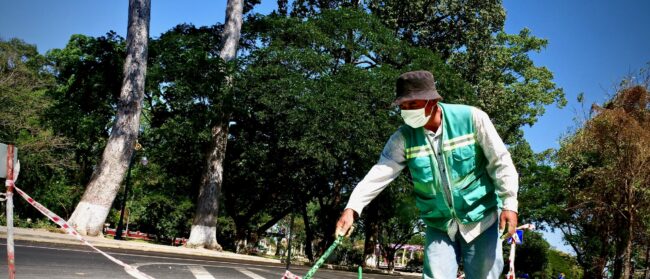To the east of Central Vietnam and south of Chinese Hainan, a group of tiny islands is causing discord in the South China Sea. The key to understanding the conflict goes back far further than contemporary headlines.
Vietnam is one of the countries that has long claimed sovereignty to the Paracels, yet they are under Chinese control. The reason can be found in a dramatic French-Chinese standoff in 1947 and a narrowly avoided war.
Disputed ground
The Vietnamese Nguyen dynasty first claimed the Paracels in 1816. Yet France, after colonising Vietnam, did not show much interest in them and China developed a rival claim in 1909. Fearing Japanese expansionism, France reasserted the Annamese (Vietnamese) claim in 1931.
When France dispatched a Franco-Vietnamese force to occupy the islands in 1938, and build a lighthouse, they found that Japan was there before them. During World War II, the Paracels were occupied by Japanese-Taiwanese and French-Vietnamese forces living side by side. Following the Japanese surrender in August 1945, the islands were abandoned and left to fishermen who stayed there on a seasonal basis.
A reconnaissance plane in November 1946 confirmed what a French ship had spotted in May: the islands were now unoccupied.

The 1947 standoff
In October 1946, the French government instructed its high commissioner in Saigon to establish a presence in the largest of the Paracels, Woody Island, and erect a meteorological station. High commissioner Georges Thierry d’Argenlieu was, however, busy preparing for war against Ho Chi Minh’s Democratic Republic of Vietnam.
The First Indochina War broke out in Hanoi on 19 December 1946. While the French and Viet Minh were fighting from house to house in densely populated Hanoi, the high commissioner decided to send a naval ship to the unoccupied Paracels in response to the French government’s instruction.
However, this time China had got there first. A French reconnaissance plane observed a group of men on Woody Island, waving Chinese flags on 10 January. When the French naval ship, Le Tonkinois, arrived seven days later the vessel was met by a Chinese detachment with three officers and 60 men.
The French notified the Chinese that the Paracels were Vietnamese territory, under French protection, and demanded they promptly leave. They refused. Threats and bribes were proffered to no effect.
Alarm bells rang in Paris and Nanjing, the capital of China’s Nationalist government. France could not afford a war with China at a time when it was fighting Ho Chi Minh’s Viet Minh forces. This would risk Chinese intervention in support of the Viet Minh.
On his side, Chinese leader Chiang Kai-shek was under pressure from his Kuomintang Party to stand firm behind his nation’s sovereignty claims in the South China Sea. Although he needed to concentrate on his war with Mao Zedong’s Red Army, Chiang could not make concessions to a colonial power.

The French Foreign Ministry briefly discussed a possible deal in which China would get the Paracels if France received the Spratlys. Instead, Paris proposed to Nanjing that the sovereignty question in the Paracels be brought to arbitration by the International Court of Justice in the Hague.
Chiang Kai-shek refused. Regardless of the regime, China has been reluctant to leave boundary decisions to outsiders, instead insisting on negotiating its boundaries bilaterally with each of its neighbours. In 2014, China also refused to play any part in a compulsory arbitration initiated by the Philippines to resolve certain legal issues concerning the Spratlys. This led to a judgement in 2016 by an arbitral tribunal constituted under the UN Convention on the Law of the Sea, saying China had no historic rights over sea areas inside its 9-dashed line and that none of the Spratly islands could have an economic zone or continental shelf of their own. This was a judgement that no Chinese government could ever accept.
The January 1947 standoff at Woody Island ended with Le Tonkinois sailing away. Instead of confronting the Chinese forces, the ship set course for Pattle Island in the southwestern part of the Paracels and delivered a French-Vietnamese garrison. The Paracels were subsequently divided between a Chinese Amphitrite and Vietnamese Crescent group.
Competing claims

In May 1947, the Republic of China’s parliament urged Chiang to recover the rest of the Paracels, including the now French-held Pattle Island. With force if necessary. Yet Chiang was too busy fighting Mao. When Chiang fled to Taiwan in 1950 and Mao took full control of the Chinese mainland, Chiang’s garrison at Woody Island was withdrawn.
The Amphitrite group was left unoccupied for the next five years, while the French-controlled State of Vietnam continued to hold Pattle Island in the Crescent group. China re-established a presence on Woody Island in 1955.
The division of the Paracels lasted until 1974. At a time when South Vietnam could no longer count on US support, Mao did what Chiang had been urged to do in 1947. Mao used force to take the whole of the Paracels, where today there is a major Chinese military base.
The Socialist Republic of Vietnam staunchly maintains Vietnam’s historical claim to sovereignty.
Stein Tønnesson is a research professor with the Peace Research Institute Oslo (PRIO) and the author of “The Vietnamese Revolution of 1945” and “Vietnam 1946: How the War Began.”


